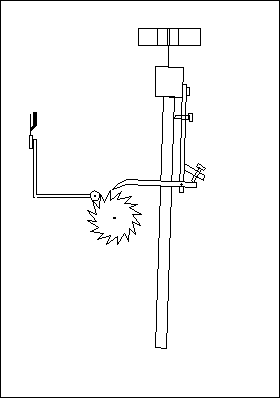This quite rare clock is mechanically and electrically similar to the ATO master clocks that were used to control slave clocks on the French rail system from the 1920s. The smaller ATO mantel clocks of the same period employed a different pendulum suspension and electrical contact arrangement from the Master clocks. Although this clock does not have the contacts for sending pulses to slave clocks, and the pendulum bob is different from the more usual ATO, the basic design and principles of operation are those of ATO. This example is marked on the dial with the name of UTILIA but the clock has no further marks on it. Unlike some innovators who set up their own manufacturing facilities in other countries (e.g. Bulle), Leon Hatot's French company (from which the name ATO is derived) licensed their ideas to other manufacturers. Usually such clocks are marked 'Lic.ATO' or similar.
The 1/2 second pendulum rod is of invar with a bob in the form of a horse-shoe shaped magnet passing through a single coil assembly. This is different from the more commonly found ATO pendulum which has a slightly curved magnet extending each side of the pendulum rod (in the form of an inverted T), with the magnet passing through an impulse coil on one side and a dummy coil, which is usually a single turn damping coil to check excessive pendulum swing, on the other. On this example, the two end-plates of the coil former are uncut brass discs which I believe would act in a similar fashion to a separate damping coil. This pendulum/impulse design was patented by Etablissements Leon Hatot in Britain in 1924 (Patent No. 241856).

On each right-to-left swing of the pendulum, a pawl attached to the pendulum advances a toothed wheel by one tooth (i.e. one tooth per second). An L-shaped lever has a small roller on one end which also engages with the toothed wheel and acts as a back stop. When the roller rides over the point of a tooth, the other end of the lever closes electrical contacts to pass current from a 1.5 volt battery to the coil to impulse the pendulum. Impulse is arranged to occur when the pendulum is crossing the centreline of its swing, which is the ideal timing to cause minimum disruption to the pendulum.
This image shows the switch contacts on the L-shaped lever (on the right), and the indexing pawl attached to the top of the pendulum rod (behind). The first wheel of the movement with the seconds arbor is visible below the lever. The circular movement plates are quite small, being approximately 50 mm in diameter.
The maker's name on the dial is UTILIA, and there is the usual French "Patented" mark under the 6.
I have not found any other references to this maker, and I would be grateful for any further information. (My e-mail address is on the Home page.)